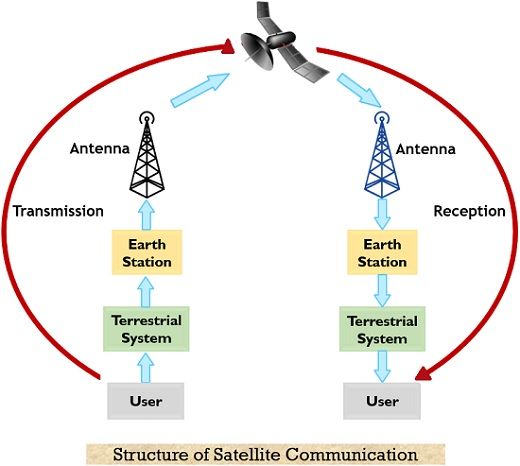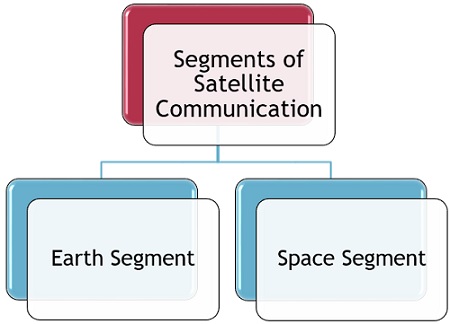Satellite Communication is defined as a type of communication where the exchange of information takes place between different stations present on the surface of the earth using artificial satellites in space. And this communication occurs within the electromagnetic spectrum.
So, in simplest terms we can say when communication between two or more ground-based units is done by making use of satellite is known as satellite communication.
In the field of telecommunications, satellite communication acts as a crucial parameter that facilitates easy and fast signal transmission and reception, where the signals can be analog or digital in nature. Through satellite communication, data, voice, audio, video signals can be transmitted and received by using communication links between various regions of the earth.
Sometimes folks interchangeably use ‘satellite communication’ and ‘communication satellite’. However, the two terminologies are quite different. Satellite Communication corresponds to the way communication occurs by the use of satellites, while Communication Satellite denotes the various individual artificial satellite units that serve as a major part of satellite communication.
Content: Satellite Communication
Need for Satellite Communication
Besides all the above discussion, one of the major questions that come to our mind is:
Why do we actually need satellite communication?
In early times, mainly there were two kinds of communication technologies that were used for long-distance signal transmission from an end to another. These are as follows:
- Ground Wave Propagation: This type of radio wave propagation allows signals of frequency up to 30 MHz to get transmitted from an end to another. It uses the troposphere layer of the atmosphere to propagate the signals from one end to another.
- Sky Wave Propagation: This type of radio wave propagation is suitable for signal transmission that falls in the range of 30 to 40 MHz. It is different from ground wave propagation because, in this type, signals are transmitted by getting refracted from the ionospheric layer of the atmosphere.
In both the above-discussed propagation techniques, the maximum permissible transmission distance between stations is nearly 1500 km. To overcome this downside of radio wave propagation, satellite communication came into existence. As through satellite communication, even signals that cannot transmit either through LOS, ground wave, or sky wave propagation, can transmit from an end to another by making use of satellite orbiting in space.
Development of Satellite Communication
The use of satellites for the purpose of communication has tremendously advanced technological development regarding communication. Satellite communication offers global coverage in a powerful and efficient manner. This technology is very famous and preferable now a day. One of the best features of satellite communication is its ability to link a large number of users present on the surface of the earth at the same time.
A Britisher, Arthur C Clarke had given the idea of long-distance radio communication that makes use of satellites orbiting around the earth.
With rapid technological development, in the 1920s, long-distance microwave communication has grown rapidly. The world’s first artificial satellite named Sputnik 1 was launched in October 1957 by Soviet Union (Russia). The launch of Sputnik into space was a remarkable step towards technical advancement. With the passage of time, various other satellites were launched into space that has gained worldwide popularity.
Almost after 18 years of the arrival of Sputnik, India also launched an artificial satellite named Aryabhata in the month of April, the year 1975.
How does satellite communication work?
The basis of satellite communication is the communication satellite which is nothing but an artificial unit that orbits the earth. The satellite in space receives a signal from a ground-based station, performs amplification and necessary processing then retransmit it back towards one or multiple earth-based stations that receives the incoming signal. The information that gets exchanged between two earth-based stations neither originates nor terminates at the satellite orbiting space. The satellite simply acts as an active transmission relay used in microwave communications.
ITU is responsible for managing the motion of satellites in space. We have already discussed that through satellite communication, information is transported from one place to another by making use of satellite.
The figure below represents a satellite communication system:

Here we have two stations that are present at two different geographical locations and are separated several kilometers of distance apart. From the above figure, we can list the major components of satellite communication. There are in general two major components of satellite communication,

The space segment is responsible for serving the specific ground segment. The characteristic that each segment possesses relies on the type of service required to be provided and the respective application. The user which is a part of the ground segment generates the baseband signal which can be voice, data, audio, video, etc. and this signal is to be transmitted at the other end.
The earth segment contains the user station with the required terrestrial network and antenna unit. By the use of an antenna unit, the signal is sent towards the satellite orbiting in space. The TT&C system is a crucial part of the user station. TT&C stands for tracking, telemetry, and command system. The motion of the satellite in space is controlled by the earth-based station. The TT&C is responsible for the same. It provides the necessary management and control required by the spacecraft to keep it in the desired orbit.
To achieve this, the TT&C system links the earth-based station and satellite together however, this link is different from the user link that connects with the satellite for signal transmission and reception. The control signals generated by the TT&C system are of a different frequency than that of the actual information signal so that the two must not interfere with each other.
The link that forms a connection from the user station to the satellite is known as uplink.
Satellites constitute the space segment which includes satellite transponders, power systems (Solar Panels for providing excitation), propulsion systems (such as rockets to propel the satellite), thrusters, etc. The transponders are nothing but the units that are responsible for both the transmission and reception of signals within the satellite. It receives signals coming from the ground station and after necessary processing, retransmits it towards other ground stations.
The power to the operation of the satellite is provided either by solar panels or batteries (in the case of eclipse). The propulsion system helps in maintaining the satellite in the correct orbital position according to the information obtained from the ground terminal.
Thrusters are in-built units present in the satellite used for occasionally adjusting the position of spacecraft. The process by which a satellite is maintained in the correct orbital position is known as station-keeping. The link from satellite to earth station is called the downlink.
It is to be noted here that the ground terminal can be fixed and mobile units. Fixed Terminals are of stationary nature and designed to remain at a particular position on the surface, for example, VSATs. On the contrary, Mobile Terminals are movable and are designed to communicate during motion also, for example, GPS.
Thus, whenever, information is required to get exchanged between one station to another or broadcasted from one station to various others, then the transmitting station makes use of a ground-based antenna through which the signal is sent to the satellite orbiting earth. This signal is then retransmitted towards the ground by the satellite and the desired station receives the amplified signal from the satellite.
Advantages
- In satellite communication, a single satellite in space offers one-third of global coverage.
- As it is a wireless mode of transmission, thus, excessive cabling requirements do not exist.
- Satellite communication utilizes microwave frequencies thus offers good bandwidth utilization.
- Signal fading is quite less thereby offering reliable communication.
- The utilization of frequency bands is properly controlled by international agencies thus; chances of interference are least as possible.
- It provides an efficient and convenient way to establish communication between such two-point that are separated by quite large distances.
Disadvantages
- The system is quite complex due to the presence of ground and space segments.
- It is expensive.
- Satellite acts as the major component of the overall communication system and malfunctioning of the satellite will hinder the performance of the overall system.
Applications of Satellite Communication
In various communication-related activities like Television, email and internet services, etc. It is also used in remote sensing and earth observation applications. Various military applications make use of satellite communication, for short-range information transmission or in detecting the enemy camps, etc. Along with these, one of the major applications includes meteorological surveys to study different weather conditions and atmospheric contents.
Satellite communication also shows usefulness in long-distance telephony-related applications as well as in radio broadcasting and telecasting of online events like sports events, historical functions, etc.